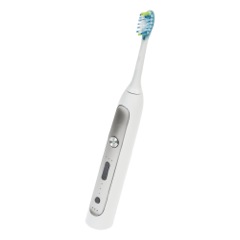 Strolling down the dental aisle, you’ve no doubt seen the myriad choices available when it comes to choosing a toothbrush. From the classic manual flathead to the $100-plus electric, the choices have become a big business. Are you choosing the right one?
Strolling down the dental aisle, you’ve no doubt seen the myriad choices available when it comes to choosing a toothbrush. From the classic manual flathead to the $100-plus electric, the choices have become a big business. Are you choosing the right one?
If you’re reading this, you’ve likely been brushing your teeth for many years and maybe you’ve tried several kinds, or maybe you stick with what you’ve always used. One question that we’ve been asked more than once is whether the cost of a “sonic” toothbrush is worth the investment.
Surprisingly, the answer isn’t a simple “yes” or “no.” Rather, it depends on a couple of important factors, including your preference for technology and, more important, your oral hygiene habits.
What Makes a “Sonic” Toothbrush Special?
The sonic toothbrush, such as Phillip’s “Sonicare,” is touted as the toothbrush that cleans areas in your mouth your normal toothbrush can’t; or it can whiten your teeth in just one week. Beyond the marketing, sonic toothbrushes are, in fact, a very specialized type of electric toothbrush that — unlike other brushes — can clean deep between teeth. The vibrations from the sonic technology and the speed at which the toothbrush head vibrates are significantly faster and more powerful than your average electric toothbrush — and certainly more than a manual toothbrush. The sonic technology helps create a flow of saliva, when mixed with toothpaste, that does penetrate deeper between your teeth and below the gum line.
People who use the sonic toothbrush have said they love the way their teeth feel after they brush … “almost like they’ve had their teeth professionally cleaned.” There is no doubt that the technology of this toothbrush is great.
With that said, there is little scientific data to support the true medical benefits of sonic versus manual toothbrushes. A 2012 study published in the Journal of the Indian Society of Periodontology concluded that, “in general there was no evidence of a statistically significant difference between powered and manual brushes.” It did, however, go on to say that, “…[sonic] brushes significantly reduce plaque and gingivitis in both the short-term evaluations.”
What Are the Cons?
The most obvious drawback to the sonic toothbrush is the hefty price tag. You can expect to pay at least $50 for one and that’s if you can find an older model that’s on sale. You’ll also have to buy replacement heads just like you have to replace toothbrushes. Most of these toothbrushes are at least $100. Prices and models vary, but a big price tag is consistent — expensive.
Who Will Benefit From It?
If you’re someone who listens to your dentist’s recommendations by brushing and flossing as recommended, you’re likely cleaning everywhere a sonic toothbrush does, in which case it probably isn’t worth the financial investment to upgrade to a sonic toothbrush.
However, if you skip flossing (like so many people do), a sonic toothbrush would probably be a wise investment. Mind you, a sonic toothbrush shouldn’t supplant the place of flossing, but for those that don’t do it, it can at least partially combat the effects of… laziness. When it comes down to it, though, brushing with a standard toothbrush for two minutes and then flossing does a better job at keeping your teeth clean than brushing with a sonic toothbrush and not flossing.
Ultimately, your oral health is important and if you know your brushing and flossing habits, you will be better able to choose the best type of brush for you. The biggest thing is to be conscious of your oral health.